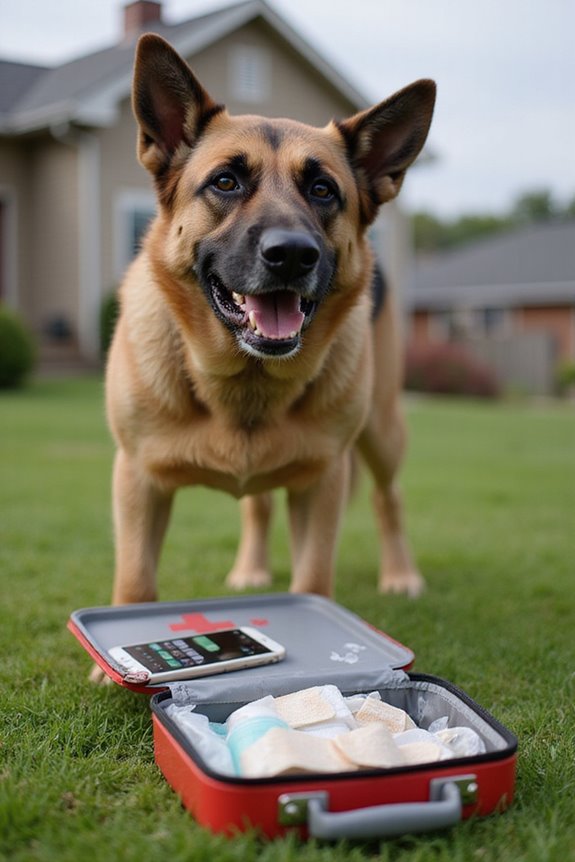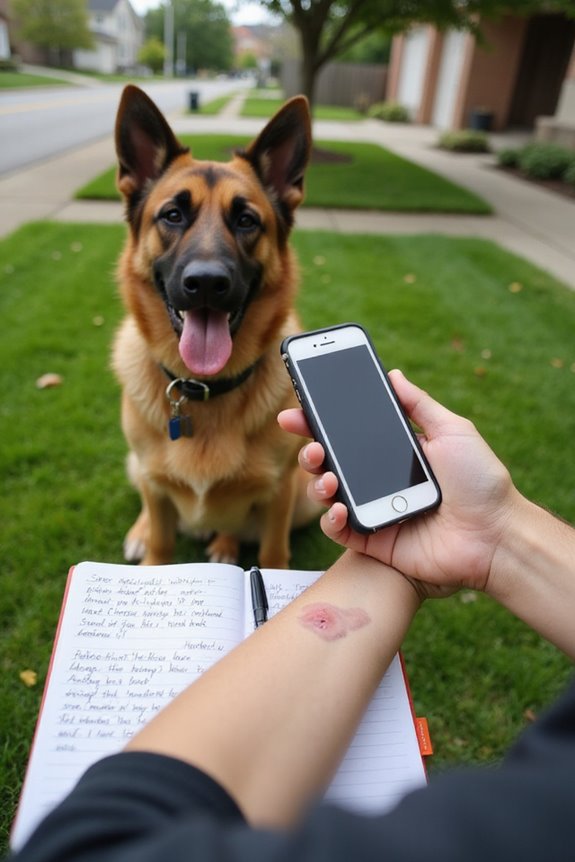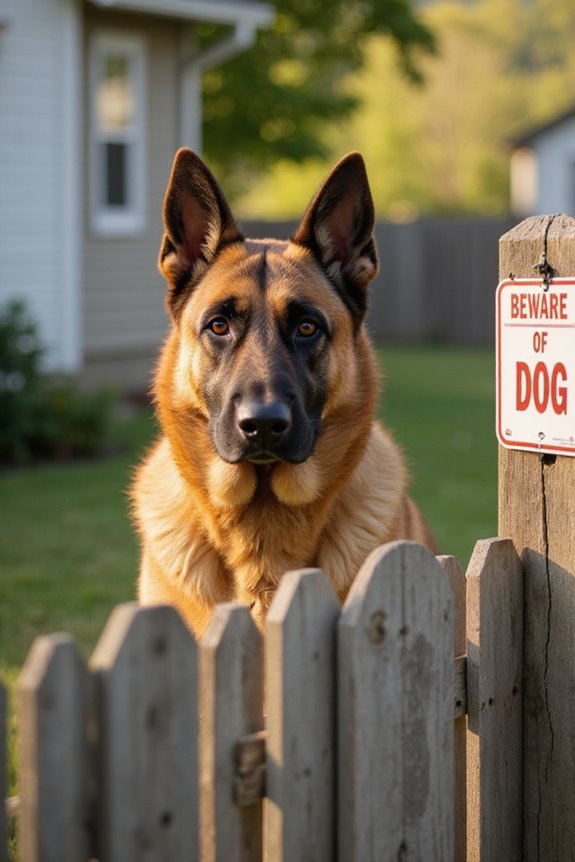To handle dog bite liability, it’s essential to understand state laws, which vary widely. In many states, owners face strict liability if their dog bites someone, regardless of negligence. First, guarantee safety by moving away from the dog and notifying animal control. Document the scene and injuries with photographs and witness statements. Review your insurance policy for coverage limits and exclusions. Finally, explore legal options for damages, including medical expenses and emotional suffering, as there’s much more to reflect upon.
Key Takeaways
- Determine if your state follows strict liability or the “one-bite rule” to understand the owner’s potential liability.
- Immediately secure your safety by moving away from the dog and contacting animal control if aggressive behavior persists.
- Document the incident by taking photographs of injuries, the scene, and gathering witness statements for future claims.
- Review the dog owner’s insurance policy for liability coverage, noting any exclusions related to specific breeds.
- Consult with a legal professional promptly, as statutes of limitations may restrict the time for filing a claim.
Understanding Dog Bite Liability Laws
Understanding Dog Bite Liability Laws is vital for both dog owners and victims, as these laws determine who is financially responsible when a dog bites someone. Dog owner responsibilities vary notably by state laws. Generally, around 36 states enforce strict liability statutes, meaning owners are liable regardless of negligence. In these states, knowledge of a dog’s dangerous tendencies isn’t necessary, except in special circumstances such as provocation or trespassing. Conversely, some states apply a “one-bite rule,” requiring a history of aggression to establish liability. Additionally, negligence may arise if an owner fails to manage foreseeable risks. It’s essential for both parties to understand these laws, as they impact legal outcomes following a dog bite incident.
Steps to Take Immediately After a Dog Bite Incident

When a dog bite occurs, it is crucial to take immediate action to guarantee your safety and well-being. Start by moving away from the dog to a secure location, staying calm to minimize further agitation. Notify animal control if the dog seems aggressive.
Next, administer first aid by washing the wound with mild soap and water for 3 to 5 minutes. Apply antiseptic and cover the wound with a sterile bandage. For serious bleeding, apply pressure and seek urgent care.
Following these steps, visit a healthcare provider as soon as possible, even if the bite looks minor. They’ll assess the risk of infections like tetanus or rabies. Remember, an immediate response can greatly influence your recovery.
Gathering Evidence and Documentation

After ensuring your immediate safety and attending to any injuries, the next step involves gathering evidence and documentation pertinent to the dog bite incident.
- Document the scene: Capture photographs of the location, the dog, and any damaged belongings. Note environmental factors contributing to the incident.
- Photograph injuries: Take close-up photos of bite wounds and related injuries, documenting progress over time.
- Collect witness statements: Secure names, contact details, and written accounts from anyone who observed the attack. Their insights into the dog’s behavior are vital for your case.
- Owner and dog information: Gather the owner’s details and any relevant veterinary records.
- Personal journal: Maintain a log of symptoms, treatment, and their impact on daily life.
Effective evidence collection and witness interviews are essential to strengthening your claim.
Exploring Insurance Coverage for Dog Bite Claims

Steering through the complex landscape of insurance coverage for dog bite claims is essential for pet owners, as it greatly impacts financial responsibility in the event of an incident. Many standard homeowners and renters insurance policies offer liability coverage for dog bites, typically between $100,000 and $300,000. However, it’s vital to review your policy carefully, as some may include insurance exclusions based on breed classifications. Certain breeds, like pit bulls and rottweilers, can result in higher premiums or even exclusion from coverage altogether. Almost half of U.S. households own dogs, making awareness of insurance options even more important. Understanding your coverage limits will help you avoid potential financial pitfalls in case of a dog bite incident.
Legal Options for Dog Bite Victims

Maneuvering the legal landscape after a dog bite can feel overwhelming, but understanding your options is essential for securing the compensation you deserve. As a victim, you have rights and several avenues to seek justice.
Key compensation options include:
- Economic Damages: Cover medical bills, rehabilitation, and lost income.
- Non-economic Damages: Address pain, suffering, and emotional trauma.
- Loss of Consortium: Claims for family members affected by your injuries.
- Punitive Damages: May arise if the owner was reckless.
To strengthen your claim, gather evidence of negligence, prior incidents, and seek legal counsel. Remember, statutes of limitations often require action within two years, so timely steps are crucial to uphold your victim rights and secure the compensation you need.
Preventative Measures to Reduce Liability Risks
When it comes to reducing liability risks associated with dog bites, proactive measures are essential for responsible ownership. Here are some key steps that I find important:
- Owner Education: Understanding dog behavior is essential. Recognizing signs of aggression or anxiety can prevent incidents.
- Secure Containment: Use sturdy fencing and always leash your dog in public to manage encounters with strangers.
- Vaccination Maintenance: Keep your dog’s vaccinations up-to-date, as this reduces legal complications should a bite occur.
- Behavioral Training: Invest in positive reinforcement training and early socialization to improve your dog’s behavior.
- Legal Preparedness: Understand local regulations and maintain insurance coverage with dog bite liability.
Taking these steps not only protects others but fosters a harmonious relationship with your pet.
Frequently Asked Questions
What if the Dog Owner Disputes My Claim?
If the dog owner disputes my claim, I’ll focus on gathering evidence to support my case. I’ll explore dispute resolution options like mediation, ensuring the owner understands their responsibilities in preventing negligence and harm.
Can I Sue for Emotional Damages From a Dog Bite?
I understand you’re wondering if you can sue for emotional distress from a dog bite. Yes, compensation claims are possible if you can link your emotional trauma directly to the incident. I’m here to help!
How Long Do I Have to File a Dog Bite Claim?
You’ve got two years to file your dog bite claim in Texas. Those statute limits can be strict, so don’t delay. I’d suggest acting quickly to meet those claim deadlines and protect your rights.
What Breeds Are Considered Dangerous Under the Law?
When it comes to dangerous breeds under the law, I’ve noticed pit bull regulations getting a lot of attention lately. Rising breed awareness shows these laws often overlook the individual dog’s behavior and temperament.
Can a Dog Be Put Down After Biting Someone?
I understand your concern about whether a dog can be put down after biting someone. It’s essential to contemplate the dog’s behavior and the owner’s responsibility. Every situation’s unique, and the laws vary greatly.


